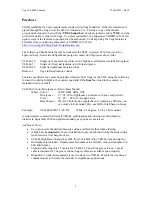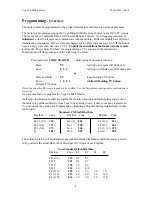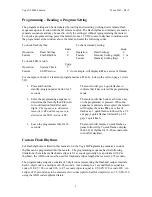
Vega VLB-44 Lantern
25 Jan 2011 - Rev 9
Programming - Overview
(cont’d)
For flash rhythms not listed on the previous page, consult Vega’s IR Programmer manual
supplied with each programmer for a nonstandard code. Pay careful attention to the existing
ON/OFF times of the light and try to match the rhythm to one listed in the manual. Note that
existing rotating beacons generally have very short flash lengths (0.05-0.2 seconds), but when
replicated by the VLB-44 the flash length is increased to 0.5-1 second (typical) with a
corresponding reduction in eclipse time (period remains the same). Strive to achieve a duty cycle
of around 10% (duty cycle is the sum of the on-times divided buy the period). As an example, a
DCB-224 in a lighthouse with a FL(2)W15 rhythm may have an existing flash rate of 0.1s FL,
4.9s EC, 0.1s FL, 9.9s EC (as detailed in the Light List). It is not practical to flash the VLB-44 at
a 0.1 second rate. A typical rhythm would be 1s FL, 4s EC, 1s FL, 9s EC. Note that the period
remains the same (15 seconds) and the duty cycle is 2s/15s x100=13.3% (close to the desired
10% mentioned above). If this desired rhythm is not listed in the IR Programming manual (it
isn’t for this example), see the section on custom rhythms.
Intensity Setting – The intensity setting or value can be found on the solar design spreadsheet,
form 3213A or the district work order. A value of 1390, for example in the effective intensity
(cd) block refers to an effective intensity of 1390 candelas and the code for that intensity is
1390
.
Note: all intensity codes are 4 digits, so an effective intensity of 77 candelas is entered as code
0077
; 109 candelas is entered as code
0109
. Note the intensity setting in the aid log and in
IATONIS under notes so that a replacement lantern can be programmed to the correct intensity.
Improper settings can affect the nominal range and the solar sizing of the aid.
5




































